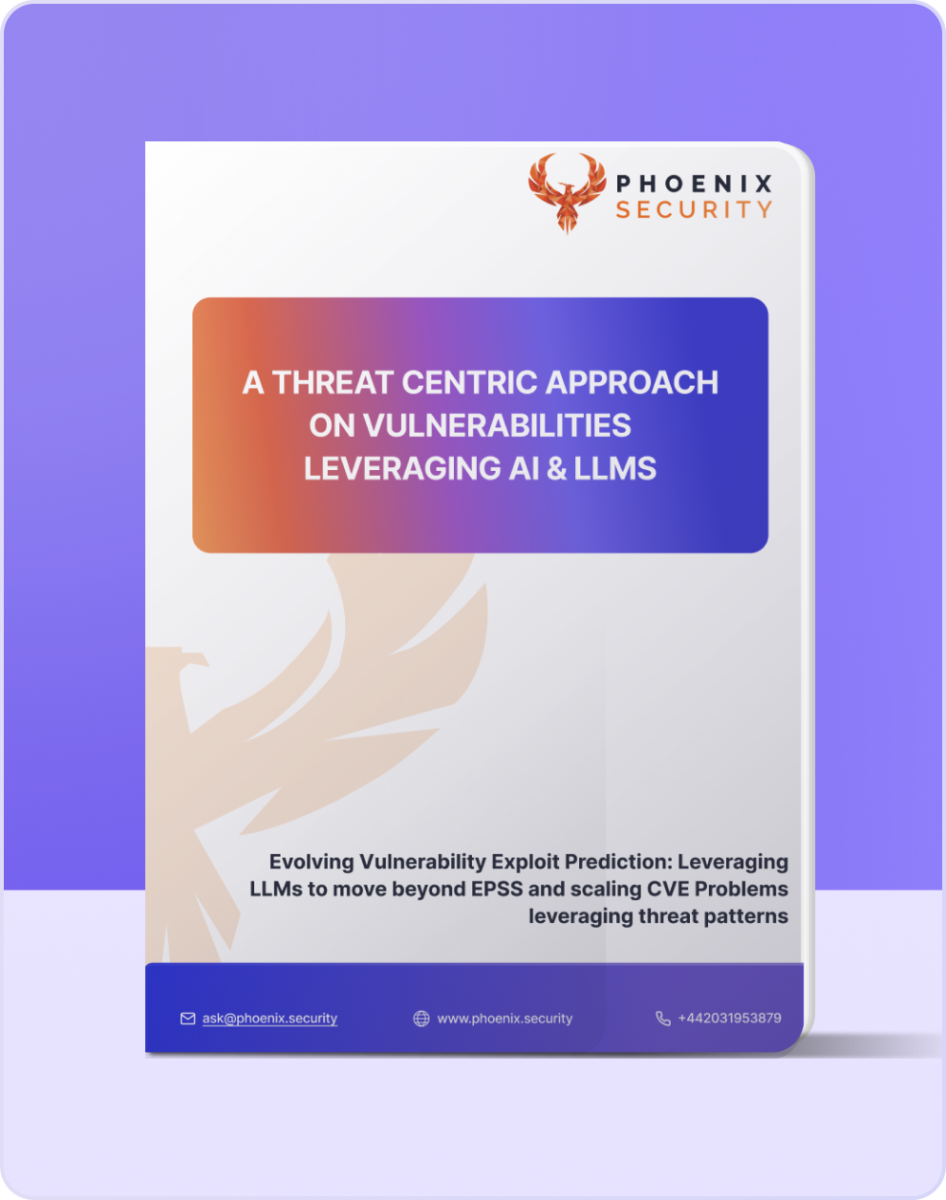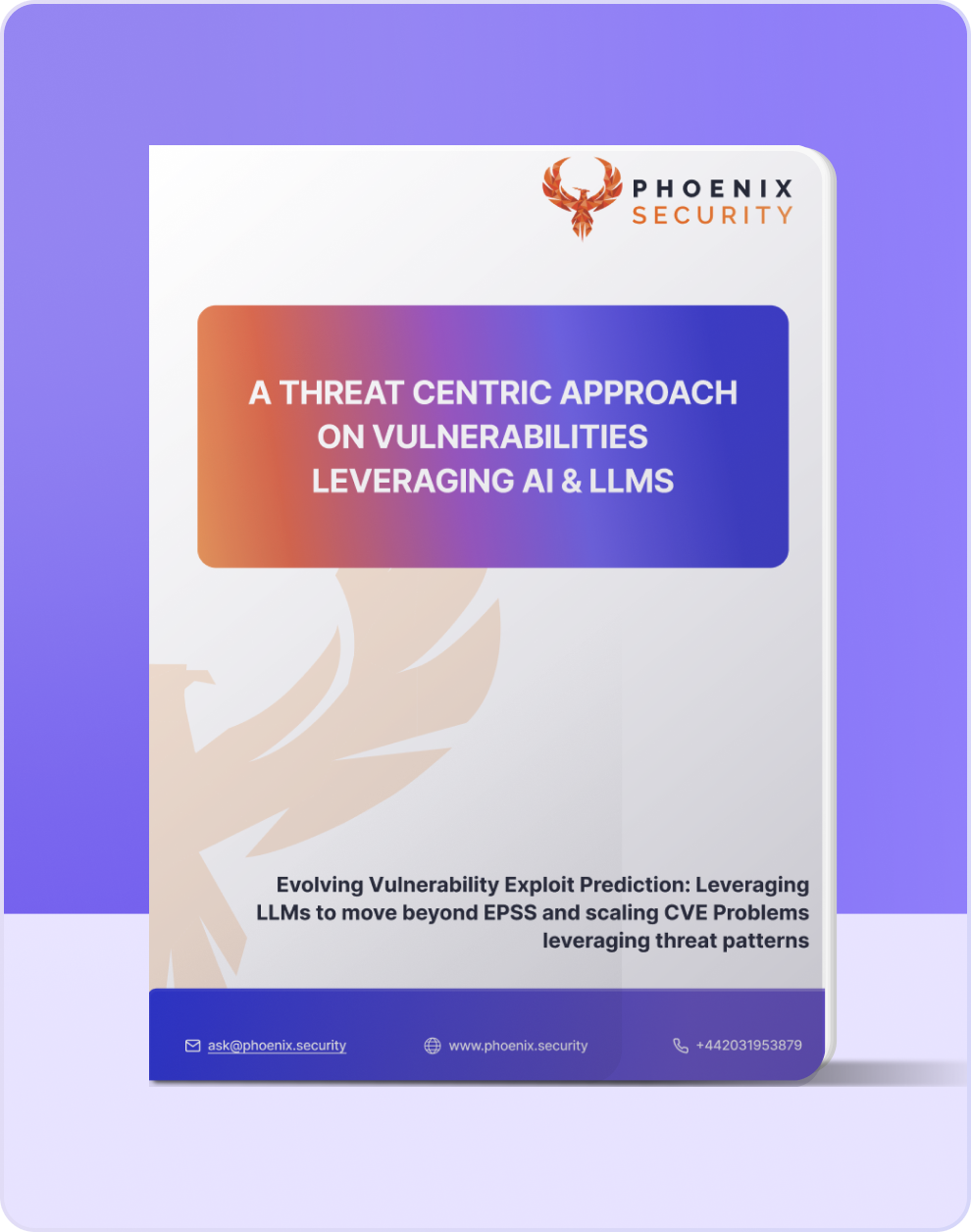Join our Mailing list!
Get all the latest news, exclusive deals, and feature updates.
Traditional patching systems struggle to prioritize which vulnerabilities to address first. This challenge highlights the need for more intelligent vulnerability management, where threat predictions and security insights are driven by advanced algorithms.
Phoenix Security in this white paper navigate the potentials of AI driven analysis on Vulnerabilities. Discover how Phoenix security has pioneered a solution for this challenge with its cutting-edge AI-driven vulnerability management system, marking a critical advancement in Application Security Posture Management (ASPM).

In this whitepaper we walk trough he method and technique used to create the world first LLM ai agent and the recursive technique to create syntetic data with LLM for LLM.
The LLM agent to analyze vulnerabilities are perfect to extract and create context for vulnerabilities. This is what powers the newly introduced AI Agent by Phoenix Security is designed to continuously assess and predict vulnerability exploitation, giving cybersecurity teams the power to focus remediation efforts on those flaws that pose the greatest risk. By analyzing a combination of vulnerability traits, historical exploitation patterns, and verified exploit data, the agent produces a high-confidence exploitation likelihood score for each vulnerability. This system empowers security professionals to align their patching priorities with actionable data, rather than relying solely on outdated CVSS scores.
The agent is powered by Phoenix Security’s AI-driven platform, which integrates deep learning to evaluate the most critical vulnerabilities. It brings real-time data from sources like the CISA KEV catalog, exploit databases, and bug bounty programs, combining this with Phoenix’s internal security intelligence to enhance vulnerability remediation and ASPM strategies.
Ransomware: What are the threat and how can you predict
Ransomware remains one of the most prolific and destructive cyber threats in today’s digital ecosystem. Ransomware attacks involve malicious actors encrypting a victim’s files or systems and demanding payment (usually in cryptocurrency) for the decryption key. These attacks can cause severe operational disruption, financial losses, and long-term reputational damage for organizations.
Through advanced AI-based vulnerability prediction models explained in the paper, Phoenix Security can identify which vulnerabilities are most likely to be exploited in ransomware campaigns. This predictive analysis helps cybersecurity teams prioritize patching efforts based on the likelihood that a vulnerability will be targeted in the near future. The ability to predict and remediate high-risk vulnerabilities significantly reduces the potential for ransomware infections, mitigating the risk of data loss, downtime, and financial impact.
By focusing on vulnerabilities with high exploitability, particularly those that could lead to code execution or privilege escalation, organizations can better protect themselves against ransomware attacks. Phoenix Security’s predictive framework leverages threat intelligence to predict ransomware likelihood, allowing organizations to take a proactive stance in their defense strategy.
Exploitation: Zero day to Exploit – Common path
Zero-day vulnerabilities are among the most dangerous threats in the cybersecurity landscape. These flaws are not yet known to the vendor or the public, meaning there is no patch or fix available when they are exploited. This window of exposure makes zero-day vulnerabilities extremely valuable to cybercriminals, who can use them to gain unauthorized access to systems, steal sensitive data, or deploy malicious payloads such as ransomware.
We explore in this paper the methods that form ransomware and zero day methodology and how to predict if a vulnerability is likely to become one of the two

Fill out the form to get all the details on how to apply LLM Agent to Vulnerabilities and how to predict which vulnerability is likely to become an exploit or a ransomware exploited by threat actors

Derek Fisher – Head of product security at a global fintech. Speaker, instructor, and author in application security.
Derek is an award winning author of a children’s book series in cybersecurity as well as the author of “The Application Security Handbook.” He is a university instructor at Temple University where he teaches software development security to undergraduate and graduate students. He is a speaker on topics in the cybersecurity space and has led teams, large and small, at organizations in the healthcare and financial industries. He has built and matured information security teams as well as implemented organizational information security strategies to reduce the organizations risk.
Derek got his start in the hardware engineering space where he learned about designing circuits and building assemblies for commercial and military applications. He later pursued a computer science degree in order to advance a career in software development. This is where Derek was introduced to cybersecurity and soon caught the bug. He found a mentor to help him grow in cybersecurity and then pursued a graduate degree in the subject.
Since then Derek has worked in the product security space as an architect and leader. He has led teams to deliver more secure software in organizations from multiple industries. His focus has been to raise the security awareness of the engineering organization while maintaining a practice of secure code development, delivery, and operations.
In his role, Jeevan handles a range of tasks, from architecting security solutions to collaborating with Engineering Leadership to address security vulnerabilities at scale and embed security into the fabric of the organization.

Jeevan Singh is the Director of Security Engineering at Rippling, with a background spanning various Engineering and Security leadership roles over the course of his career. He’s dedicated to the integration of security practices into software development, working to create a security-aware culture within organizations and imparting security best practices to the team.
In his role, Jeevan handles a range of tasks, from architecting security solutions to collaborating with Engineering Leadership to address security vulnerabilities at scale and embed security into the fabric of the organization.

James Berthoty has over ten years of experience across product and security domains. He founded Latio Tech to help companies find the right security tools for their needs without vendor bias.


Chris Romeo is a leading voice and thinker in application security, threat modeling, and security champions and the CEO of Devici and General Partner at Kerr Ventures. Chris hosts the award-winning “Application Security Podcast,” “The Security Table,” and “The Threat Modeling Podcast” and is a highly rated industry speaker and trainer, featured at the RSA Conference, the AppSec Village @ DefCon, OWASP Global AppSec, ISC2 Security Congress, InfoSec World and All Day DevOps. Chris founded Security Journey, a security education company, leading to an exit in 2022. Chris was the Chief Security Advocate at Cisco, spreading security knowledge through education and champion programs. Chris has twenty-six years of security experience, holding positions across the gamut, including application security, security engineering, incident response, and various Executive roles. Chris holds the CISSP and CSSLP certifications.

Jim Manico is the founder of Manicode Security, where he trains software developers on secure coding and security engineering. Jim is also the founder of Brakeman Security, Inc. and an investor/advisor for Signal Sciences. He is the author of Iron-Clad Java: Building Secure Web Applications (McGraw-Hill), a frequent speaker on secure software practices, and a member of the JavaOne Rockstar speaker community. Jim is also a volunteer for and former board member of the OWASP foundation.
Get all the latest news, exclusive deals, and feature updates.

